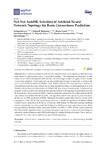Net-Net AutoML Selection of Artificial Neural Network Topology for Brain Connectome Prediction

Use este enlace para citar
http://hdl.handle.net/2183/25261Colecciones
- Investigación (FIC) [1685]
Metadatos
Mostrar el registro completo del ítemTítulo
Net-Net AutoML Selection of Artificial Neural Network Topology for Brain Connectome PredictionAutor(es)
Fecha
2020-02-14Cita bibliográfica
Barreiro E, Munteanu CR, Gestal M, et al. Net-Net AutoML selection of artificial neural network topology for brain connectome prediction. Appl Sci. 2020; 10(4):1308
Resumen
[Abstract]
Brain Connectome Networks (BCNs) are defined by brain cortex regions (nodes) interacting with others by electrophysiological co-activation (edges). The experimental prediction of new interactions in BCNs represents a difficult task due to the large number of edges and the complex connectivity patterns. Fortunately, we can use another special type of networks to achieve this goal—Artificial Neural Networks (ANNs). Thus, ANNs could use node descriptors such as Shannon Entropies (Sh) to predict node connectivity for large datasets including complex systems such as BCN. However, the training of a high number of ANNs for BCNs is a time-consuming task. In this work, we propose the use of a method to automatically determine which ANN topology is more efficient for the BCN prediction. Since a network (ANN) is used to predict the connectivity in another network (BCN), this method was entitled Net-Net AutoML. The algorithm uses Sh descriptors for pairs of nodes in BCNs and for ANN predictors of BCNs. Therefore, it is able to predict the efficiency of new ANN topologies to predict BCNs. The current study used a set of 500,470 examples from 10 different ANNs to predict node connectivity in BCNs and 20 features. After testing five Machine Learning classifiers, the best classification model to predict the ability of an ANN to evaluate node interactions in BCNs was provided by Random Forest (mean test AUROC of 0.9991 ± 0.0001, 10-fold cross-validation). Net-Net AutoML algorithms based on entropy descriptors may become a useful tool in the design of automatic expert systems to select ANN topologies for complex biological systems. The scripts and dataset for this project are available in an open GitHub repository.
Palabras clave
Artificial neural networks
Brain connectome networks
Machine learning
Net-Net AutoML
Brain connectome networks
Machine learning
Net-Net AutoML
Versión del editor
Derechos
Atribución 3.0 España
ISSN
2076-3417






